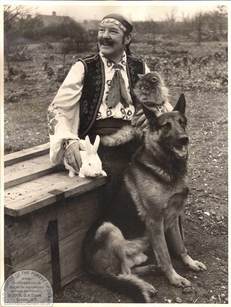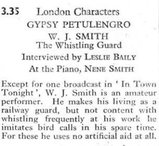XAVIER 'GYPSY' PETULENGRO
|
1859 - 1957
Xavier Petulengro, also known as Gypsy Petulengro, was more glamorously titled the ‘King of the Gypsies.’ He was a massively popular figure through the 1930s and 1940s because of his books, newspaper columns and radio broadcasts. Though he travelled widely, and lived in many places, at his own request he was buried at All Saints’ Church in Viney Hill, Forest of Dean, in what was a spectacular, ‘celebrity’ funeral. He was known to have visited the area many times during his life, and it was clearly a special place to him. The funeral was arranged by his friends Mr & Mrs Vine, who he had often stayed with and who lived opposite the church. The funeral was in traditional Romanichal style, with about 200 official mourners, some in traditional costumes, plus over 1,500 sightseers including local children given the day off from school so they could attend. He was significant in popular culture, and news of his death and funeral was broadcast all over the world. |
Picture courtesy of Sungreen
|
lIFE AND CAREER |
WRITING |
RADIO BROADCASTs |
|
(Petulengro’s life is vaguely described in a few sources mainly based on his own accounts, but needs to be judged carefully to separate mythology from reality).
Petulengro, also known as both Walter Smith and Walter Lloyd, was born into a Romani family in Rochdale, Lancashire on 25 December 1859. His father traded Welsh ponies and it is possible, but not certain, that he lived some of his early life in Romania. He was the grandson of Ambrose Smith (1804-1878), known as Jasper Petulengro, the semi-fictionalised subject of the bestselling books Lavengro (1851) and Romany Rye (1857) by George Borrow (1803-1881). Borrow’s books were very popular in the early twentieth century, evoking as they did an earlier pastoral vision of England. The ‘Gentleman gypsy’ persona created for his grandfather by Borrow, was an image that Xavier cultivated and exploited for himself. A charismatic showman with an eye for an opportunity to promote himself, he came to public attention in the 1920s when he was invited to help re-establish a tradition of gypsy celebrations at Baildon in Yorkshire, which had taken place in the area until the late nineteenth century. In 1929 the events were ‘re-invented,’ with 'real' gypsies attending alongside local people dressed up in costume. In doing this he created an illusory, romantic gypsy world and helped contribute to both his, and a wider, ‘gypsy appeal.’ From the response to his first radio broadcasts and subsequent newspaper correspondence Petulengro was alerted to the enormous interest in the herbal treatments he had presented as an alternative to visiting a doctor - whom he called the “Mullah-Mush-Engro.” At the same time his first book of remedies was published in 1935, he began establishing a mail order company selling herbs. He also advised on poaching techniques, activities for children, and ‘fake’ treatments. |
He published his first book in 1935, Romany Remedies and Recipes, followed in 1937 by an autobiography, A Romany Life. Both were published under the name Gipsy Petulengro. Along with Britain Through Gypsy Eyes (1937) these first three books were extremely popular. His others, including the novel, Fanya (1938) appear to have done less well. His book publishing ended abruptly in 1938, however by then he had other interests with his mail order business and writing horoscopes. Many of his titles were subsequently re-published after the Second World War by Lavanya Petulengro Publications.
He also wrote for numerous newspapers and periodicals beginning with the Bolton Evening News. Later, he was a prominent author in national newspapers, and The Listener. Books Romany Remedies and Recipes (1935) A Romany Life (1935) Romany Hints for Hikers (1936) Gypsy Fiddler (1936) edited by W.B. O’Hanlon Britain through Gypsy Eyes (1937) Book of Mystery (1937) Romany Love (1938) Fanya (1938) Jack by the Hedge (1946) by Nancy Price – with an introduction by Gipsy [sic] Petulengro |
His rich charismatic storytelling found a natural home on the radio. On 17 March 1934, he broadcast a programme about the origin of British Romani and it was so popular he quickly became a regular broadcaster including the first Radiolympia event that ran from 16-26th August 1934, making him a household name.
Here's just one example of his many radio appearances, taken from The Radio Times for 18th November 1936: funeral of gypsy petulengroBritish Pathe News (1957)
[no sound] |
The 1930s saw the first newspaper horoscope columns, and the allure of the romanticised gypsy had been embellished through stories of the powers of prophecy, reading palms and crystal balls that populated major events and sea side promenades. Petulengro was quick to exploit this gypsy ‘talent’ which saw him produce his Book of Mystery, explaining how to interpret the meaning of dreams, read hands and predict the future from playing cards. He became a popular figure at the Epsom Derby and on Blackpool promenade. Seeing the opportunity to exploit his credentials and sell himself to a mass audience he went on to write an astrology column, ‘Your Fate in the Stars’, in the Sunday Chronicle national newspaper and other major magazines and publications.
He appeared as the ‘King of the Gypsies’ at Romani weddings, such as that between his son Leon Petulengro and Illeana Smith in 1937. These were described as including blood rituals, and were covered by several newspapers as well as being filmed by Pathé News (which were shown in cinemas, thus adding to his fame). Petulengro’s exact status among Romani people is unclear and these ceremonies may have been simple exercises in self-publicity. In fact, he did not own the exclusive title to his name. Many fortune tellers at the time exploited the cache of the very same name, also calling themselves Petulengro. In Romani culture anyone with the family name of ‘Smith’ was entitled to use the name Petulengro, a term for ‘Shoeing Smith,’ a ‘Petula’ being a Horseshoe and an ‘Engro’ a man/person. Many using the title today may only be distant relatives of Xavier Petulengro, or even completely unrelated to him.
He appeared as the ‘King of the Gypsies’ at Romani weddings, such as that between his son Leon Petulengro and Illeana Smith in 1937. These were described as including blood rituals, and were covered by several newspapers as well as being filmed by Pathé News (which were shown in cinemas, thus adding to his fame). Petulengro’s exact status among Romani people is unclear and these ceremonies may have been simple exercises in self-publicity. In fact, he did not own the exclusive title to his name. Many fortune tellers at the time exploited the cache of the very same name, also calling themselves Petulengro. In Romani culture anyone with the family name of ‘Smith’ was entitled to use the name Petulengro, a term for ‘Shoeing Smith,’ a ‘Petula’ being a Horseshoe and an ‘Engro’ a man/person. Many using the title today may only be distant relatives of Xavier Petulengro, or even completely unrelated to him.
personal life
Xavier Petulengro’s personal life is also clouded in myth. Amelia, (also referred to as Anyeta), his wife, is attributed as teaching him much of the herbal medicine he knew. For the last twelve years of his life his constant companion was Lavanya, who he said was his sister, and who lived for a period in Viney Hill, and was buried beside him when she died in 1978. Lavanya was also a business partner being closely involved in his mail order and publications businesses. Her devotion to Petulengro is demonstrated by her funding the restoration of the organ in Viney Hill’s All Saints’ Church in memory of him.
Petulegro’s life did not reflect the harsh realities of Romani experience in places such as the Forest of Dean at the time of his death, and his writings harked back to an imaginary pre-industrial Britain. Petulengro was a phenomenal showman and entrepreneur who seized the opportunity to mass market a romanticised image of the British Gypsy and himself. Evidence of his enduring appeal and that of the name ‘Petulengro,’ is illustrated by his being referenced by Dr Harold Elletson, MP for Blackpool who, in a 1995 Parliamentary debate, said:
Blackpool is the home of the tower, the pleasure beach, the golden mile and the illuminations as well as Ripley's Odditorium and Gipsy Petulengro, the famous clairvoyant who tells the fortunes of the rich and famous—somewhat more reliably than a BBC exit poll, I understand.
However, in the Forest, Petulengro will be remembered for the conclusion of his ‘nomadic’ charismatic life, when he had a celebrity funeral filmed by British Pathé News and his caravan was burnt on the grass outside the small church of All Saints’ in Viney Hill.
Petulegro’s life did not reflect the harsh realities of Romani experience in places such as the Forest of Dean at the time of his death, and his writings harked back to an imaginary pre-industrial Britain. Petulengro was a phenomenal showman and entrepreneur who seized the opportunity to mass market a romanticised image of the British Gypsy and himself. Evidence of his enduring appeal and that of the name ‘Petulengro,’ is illustrated by his being referenced by Dr Harold Elletson, MP for Blackpool who, in a 1995 Parliamentary debate, said:
Blackpool is the home of the tower, the pleasure beach, the golden mile and the illuminations as well as Ripley's Odditorium and Gipsy Petulengro, the famous clairvoyant who tells the fortunes of the rich and famous—somewhat more reliably than a BBC exit poll, I understand.
However, in the Forest, Petulengro will be remembered for the conclusion of his ‘nomadic’ charismatic life, when he had a celebrity funeral filmed by British Pathé News and his caravan was burnt on the grass outside the small church of All Saints’ in Viney Hill.
Sources
The George Borrow Society
The Petulengro Family Album by Paul Petulengro
The Role of the Romanies: Images and Counter-images of ‘Gypsies’/Romanies in European Cultures (2004) by Nicholas Saul & Susan Tebbutt
The George Borrow Society
The Petulengro Family Album by Paul Petulengro
The Role of the Romanies: Images and Counter-images of ‘Gypsies’/Romanies in European Cultures (2004) by Nicholas Saul & Susan Tebbutt
This biography is based on the research of Noel John, Reading the Forest volunteer researcher, and the generous help and advice of Paul Petulegro.
COMMENTS
Have you read one of Xavier Petulengro's books? Tell us about it here - or send us your thoughts via our contact page and we will put it here...




